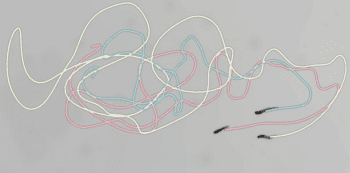
New research could help explain one of the “miracles” of childbirth – how the uterus contracts to push babies into the world. Computer models, developed by researchers in India and France, reveal that as the moment of birth approaches, the cells in the uterus become more electrically connected, enabling them to behave in synchrony. To date, it had not been clear how the cells in the uterus could act together to generate a large-scale contraction during labour.
The uterus is composed of active muscle cells plus electrically passive cells that connect and support them, with muscle cells outnumbering the passive cells. In a general sense it is believed that contractions are caused by positive ions flowing into a muscle cell via small protein complexes called gap junctions. These gap junctions electrically couple the two types of cell, and these junctions are known to multiply near the end of a pregnancy.
Earlier experiments on rats demonstrated that at the time of delivery, the electrical conductivity of the uterus was about nine times greater than it was two to three days before, which suggests that the number of gap junctions rose from about 50 to 450 per muscle cell. Structural studies have shown that gap-junction conductance could increase as much as 100-fold. However, the link between increasing the number of gap junctions and the emergence of synchronized contractions was not fully understood.
Modelling the uterus
This link is the subject of new research by a team including Sitabhra Sinha of the Institute of Mathematical Sciences, Chennai, India, working alongside colleagues at the Ecole Normale Supérieure in Lyon, France. In order to explore how increased electrical connectivity could affect the electrical oscillations of the cells, Sinha and colleagues used a computer simulation to model a network of excitable and passive elements with varying coupling strength.
The results showed that with relatively few connections between neighbours, the oscillations in the system were initially all out of synch. As the coupling increased, clusters of excitable elements began to oscillate with the same frequency. With further connections, the clusters merged, until all oscillating elements shared a frequency, with a few inactive regions. Finally, all the excitable elements oscillated in a single wave, similar to the waves observed experimentally in the uterus of a guinea pig.
“There is some evidence that in the uterus, the frequency of contractions increases as the time of delivery approaches,” says Sinha. “Our results suggest an intriguing possibility of how such increased oscillation frequencies can come about as a result of enhanced coupling between cells.”
Robert Garfield of St Joseph Hospital and Medical Center in Phoenix, Arizona, calls the study a “wonderful contribution” that supports the theory that burgeoning gap junctions among the muscular cells can bring on the “synchronous and rhythmic activity of the uterus required for delivery of the fetus”.
Excited and passive cells
But Chi Keung Chan of the Academia Sinica, Taipei, Taiwan points out that the model does not quite reflect the real electrical potentials of the active and passive cells in the uterus. “Real muscle cells in the uterus have resting potentials below that of the passive cells, but their excited potentials are above that of passive cells,” he says. In the model, the excitable cells always have a potential below that of the passive cells, whether they are resting or excited. “It is like connecting lots of batteries to the excitable cells, and it is not surprising that the system will fire continuously,” Chan adds.
According to Pik-Yin Lai of the National Central University in Jhongli City, Taiwan, the transition within uterus cells to synchronized behaviour is likely to involve other biological factors. “The onset of collective periodic contraction is mostly likely an external event caused by hormonal secretions,” says Lai, pointing out that an oxytocin injection can induce contractions in about 10 min.
Sinha agrees that the role of hormones must be included, and that this is another current research direction for his collaboration. “Our preliminary simulations show that increased excitability of the excitable cells results in a transition to coherent activity,” he says, and he notes that when the gap junctions between cells were dissolved in other experiments, a hormone injection could no longer induce collective contractions.
This research is published in Physical Review Letters.



